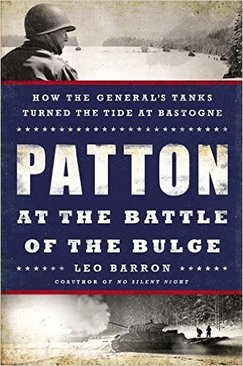PUBLISHED/NAL Caliber WWII/military history
Patton at the Battle of the Bulge: How the General's Tanks Turned the Tide at Bastogne
Leo Barron

December 1944. For the besieged American defenders of Bastogne, time was running out....
Hitler’s forces had pressed in on the small Belgian town in a desperate offensive designed to push back the Allies, starting the Battle of the Bulge. So far the U.S. soldiers had managed to repel waves of attackers and even a panzer onslaught. But as their ammunition dwindled, the weary paratroopers of the 101st Airborne could only hope for a miracle—a miracle in the form of General George S. Patton and his Third Army.
More than a hundred miles away, Patton, ordered to race his men to Bastogne, was already putting in motion the most crucial charge of his career. Tapped to spearhead his counterstrike against the Wehrmacht was the 4th Armored Division, a bloodied but experienced unit that had fought and slogged its way across France. But blazing a trail into Belgium meant going up against some of the best infantry and tank units in the German Army. Failure to reach Bastogne in time could result in the overrunning of the 101st—a catastrophic defeat that could turn the tide of the war and secure victory for the Nazis.
In Patton at the Battle of the Bulge, Army veteran and historian Leo Barron explores one of the most famous yet little told clashes of the war, a vitally important chapter in one of history’s most legendary battles.
Hitler’s forces had pressed in on the small Belgian town in a desperate offensive designed to push back the Allies, starting the Battle of the Bulge. So far the U.S. soldiers had managed to repel waves of attackers and even a panzer onslaught. But as their ammunition dwindled, the weary paratroopers of the 101st Airborne could only hope for a miracle—a miracle in the form of General George S. Patton and his Third Army.
More than a hundred miles away, Patton, ordered to race his men to Bastogne, was already putting in motion the most crucial charge of his career. Tapped to spearhead his counterstrike against the Wehrmacht was the 4th Armored Division, a bloodied but experienced unit that had fought and slogged its way across France. But blazing a trail into Belgium meant going up against some of the best infantry and tank units in the German Army. Failure to reach Bastogne in time could result in the overrunning of the 101st—a catastrophic defeat that could turn the tide of the war and secure victory for the Nazis.
In Patton at the Battle of the Bulge, Army veteran and historian Leo Barron explores one of the most famous yet little told clashes of the war, a vitally important chapter in one of history’s most legendary battles.
ABOUT THE AUTHOR
Leo Barron has significant name recognition within the military intelligence community; he teaches a significant portion of the military intelligence officers in the U.S. Army. He has directly instructed over 350 captains over the past three years. Barron also has a growing name recognition among military historians, which is how he and Cygan met.
Two books on the 101st Airborne in Iraq, Black Hearts and Along the Tigris, refer extensively to Barron. He holds undergraduate and graduate degrees in history, and has seen several tours of active duty in the military. Unlike some popular writers, Barron is both a trained historian and a veteran, who knows what it is like to feel the pace of battle and to see people die.
His articles about Bastogne and other WWII-related military topics have appeared in Infantry magazine, Military Intelligence Professional Bulletin, WWII magazine, and WWII History magazine.
Two books on the 101st Airborne in Iraq, Black Hearts and Along the Tigris, refer extensively to Barron. He holds undergraduate and graduate degrees in history, and has seen several tours of active duty in the military. Unlike some popular writers, Barron is both a trained historian and a veteran, who knows what it is like to feel the pace of battle and to see people die.
His articles about Bastogne and other WWII-related military topics have appeared in Infantry magazine, Military Intelligence Professional Bulletin, WWII magazine, and WWII History magazine.
